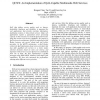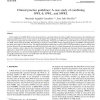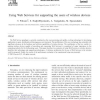MTA
2006
14 years 2 months ago
2006
QoS, that defines service quality such as latency, availability, timeliness and reliability, is important for web applications that provide real-time information, multimedia conte...
FGCS
2007
14 years 2 months ago
2007
The integration of Web services is a recent outgrowth of the Business Process integration field that will require powerful meta-schema mechanisms supported by higher level abstra...
FGCS
2007
14 years 2 months ago
2007
— The performance and efficiency of Web Services can be greatly increased in conversational and streaming message exchanges by streaming the message exchange paradigm. In this pa...
JUCS
2006
14 years 2 months ago
2006
: PEWS is a language for the implementation of web service interfaces. PEWS programs can be used for the description of both individual and composed web services. Individual web se...
JSS
2006
14 years 2 months ago
2006
This article analyses two most commonly used distributed models in Java: Web services and RMI (Remote Method Invocation). The paper focuses on regular (unsecured) as well as on se...
ENTCS
2007
14 years 2 months ago
2007
Recently the term Web Services choreography has been introduced to address some issues related to Web Services composition and coordination. Several proposals for describing chore...
KBS
2008
14 years 2 months ago
2008
As the number of available Web services increases there is a growing demand to realise complex business processes by combining and reusing available Web services. In this context,...
JWSR
2008
14 years 2 months ago
2008
: Web Services can be used to automate business activities that span multiple enterprises over the Internet. Such business activities require a coordination protocol to reach consi...
DSS
2007
14 years 2 months ago
2007
The Web Service paradigm is currently considered as the most promising and rapidly evolving technology for developing applications in open, distributed and heterogeneous environme...
JUCS
2008
14 years 2 months ago
2008
: Architectural mismatches are a recognized obstacle to successful software reuse. An architectural mismatch occurs when two or more software components are connected to form a sys...




